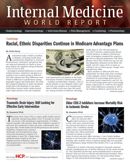Publication
Article
Older COX-2 Inhibitors Increase Mortality Risk in Ischemic Stroke
Author(s):
A new Danish database analysis in the November 2014 issue of Neurology, indicated increased mortality after ischemic stroke in patients taking older non-steroidal anti-inflammatory drugs (NSAIDs) that inhibit COX-2 (e.g. diclofenac, etodolac).

Cyclooxygenase inhibition’s effect on outcomes after cerebral ischemia is controversial, with some researchers having reported that based on animal studies, COX-2 inhibition should reduce edema, neuroinflammation, and infarct size. Others postulated it should not (based on mechanisms of action) adversely affect outcomes. A new Danish database analysis in the November 2014 issue of Neurology, indicated increased mortality after ischemic stroke in patients taking older non-steroidal anti-inflammatory drugs (NSAIDs) that inhibit COX-2 (e.g. diclofenac, etodolac).
Researchers at Aarhus University Hospital in Denmark examined whether preadmission use of NSAIDs influenced 30-day stroke mortality. They identified all first-time stroke hospitalizations in Denmark between 2004 and 2012 (n=100,043) and determined mortality. About half of patients had ischemic strokes, 12% had intracerebral hemorrhages, 5% had subarachnoid hemorrhages, and 32% experienced unspecified stroke. NSAID use was stratified as current (and subdivided into new or long-term), former, and nonuse. Among current users, ibuprofen was used most often (51%), followed by diclofenac (27%), etodolac (11%), naproxen (3%), and celecoxib (1%).
Current users of any selective COX-2 inhibitors were at 1.19 times the risk for mortality from ischemic stroke compared with nonusers, and the researchers indicate that this overall rate was influenced heavily—and increased—by patients who were new users of older COX-2 inhibitors.
Ischemic stroke victims who had started on older COX-2 inhibitors within 60 days of admission were 42% more likely to die within 30 days compared to patients who were not taking NSAIDs other than aspirin. The specific hazard ratios were 1.53 for etodolac and 1.28 for diclofenac.
Former users of etodolac or diclofenac were not at increased risk, nor were patients who were former or current users of nonselective NSAIDs or clecoxib. None of the drugs was associated with increased or decreased risk of death following hemorrhagic stroke.
The study was not structured to establish causality. The researchers suggested several causal mechanisms, indicating older COX-2 inhibitors might:
· Induce thromboembolism, causing larger, more severe occlusions
· Increase risk of post-stroke cardiovascular events including recurrent stroke
· Impair beneficial inflammatory responses to ischemic stroke
The researchers recommend avoiding etodolac and diclofenac in patients at high risk of arterial thromboembolism (e.g., atrial fibrillation patients with high CHA2DS2-VASc score). They suggested prescribers use alternative treatments for these patients.






